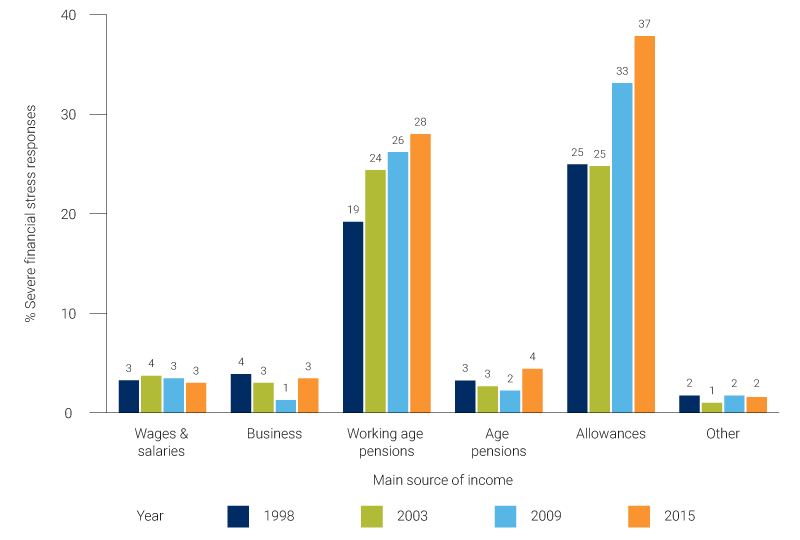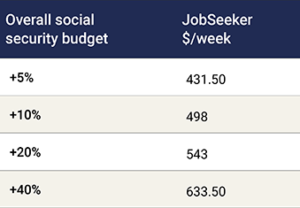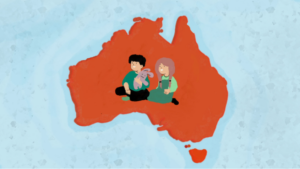
How to reduce child poverty in Australia
New research from the Australian National University has SVA and Brotherhood of St Laurence calling on the government to raise income support rates given the current levels predict dire outcomes for children and families relying on social security payments.

- The early years are critical to brain development and negative experiences, such as child poverty, can undermine a child’s long-term health and wellbeing and result in significant negative impacts in later life.
- SVA and Brotherhood of St Laurence (BSL) commissioned new research from the Australian National University which shows the positive impacts of the coronavirus supplement on child poverty rates and levels of financial stress in Australia. The research also modelled what level of income support would be required to reduce poverty and financial stress significantly.
- We have an opportunity to stop demonising families and children on income support and change the narrative to instead support them during their time of need and reduce child poverty in Australia.
- Given the research shows that current levels of income support predict dire outcomes for child poverty among families relying on social security payments, SVA is calling on the government to raise income support rates to prevent negative outcomes for Australian children.
This article looks at how child poverty can affect an individual’s whole life and how adequate levels of income support can reduce the impacts. It also looks at why SVA and Brotherhood of St Laurence (BSL) commissioned research by ANU into the impacts of the coronavirus supplement on child poverty and modelled what level of income support would be needed to reduce poverty and financial stress significantly. Results are published in the report Financial Stress and Social Security Settings in Australia. Based on the modelling, SVA and BSL have also presented recommendations to government aiming to reduce child poverty in Australia.
Why child poverty matters
There is an abundance of research that shows just how important the first three years of a child’s life are and the influences upon it. We know that these early years are critical to brain development and that negative experiences in childhood have significant impacts in later life. All Australian children deserve the opportunity to reach their potential and have healthy, productive and fulfilling lives.
“… we know that an investment in those early years is when we have the biggest impact on later life outcomes.”
However, this is far from the case with an estimated 1 in 5 children in Australia living in poverty today. We know this undermines a child’s long-term health and wellbeing and can lead to poorer outcomes. Childhood poverty comes at great cost to individuals, our economy and society. It increases children’s likelihood of experiencing disadvantage later in life and creates significant costs to society through the justice and welfare systems. Financial stress is also the leading cause of relationship breakdown in families, so reducing these factors can have a profound impact on children’s life trajectories. Families receiving payments such as JobSeeker struggle on incomes that have not increased in real terms for over 25 years.

At the launch of the ANU report findings, Anne Hollonds, National Children’s Commissioner, emphasised the importance of a child’s early years.
“I’ve spent a lot of my career advocating for more attention to the early years of life because we know that an investment in those early years is when we have the biggest impact on later life outcomes,” said Hollonds.
“This is when we’re building the foundational human capabilities that enable us to make friends, to complete our education, to get a job, to stay off the streets, and stay out of jail.”
What happened to child poverty during Covid
Australia has just been through a tumultuous time where we have faced natural disasters, followed in quick succession by a global pandemic. The Federal Government acted swiftly and implemented a range of policy responses including the temporary coronavirus supplement, which effectively doubled the income of people receiving JobSeeker and parenting payments. Parents, all of a sudden, had enough money to buy healthier food, schoolbooks and medical care for their children, ensuring kids were protected from the effects of living without enough money to get by. Millions of children and families felt the positive benefits and impacts when their income support was significantly increased. Without the extra support, hundreds of thousands more parents and children would have been left without the means to get by, leading to poorer health and social outcomes for a significant proportion of the population.
“We’ve just been through an extraordinary period where, despite sharp increases in unemployment over Covid, child poverty rates actually dropped because of a government policy measure which made an incredible difference to children,” said Emma Sydenham, Director Early Childhood, SVA.
Why we commissioned research and what it examined
To better understand the effect of these policy changes, Social Ventures Australia and the Brotherhood of St. Laurence commissioned econometric modelling from the Centre for Social Research and Methods at the Australian National University. The research modelled:
- Australian trends in poverty, child poverty and financial stress for families relying on income support;
- the impact of the Covid-19 pandemic and resulting income support changes on poverty and child poverty rates; and
- the optimal level of income support required to reduce poverty and financial stress for families and children in the most cost-effective way.
SVA’s summary of findings and recommendations
1. Australian trends in poverty, child poverty and financial stress
The research estimates trends in financial stress, poverty and child poverty for different types of households with different sources of income, levels of income and different family types.
The research shows that the social security system has been failing many people, with four in 10 people receiving income support experiencing severe financial stress: not heating their home in winter, skipping meals and seeking assistance from charities and welfare organisations (see Figure 1). Severe financial stress has steadily increased for those on income support in Australia since 1998.

As expected, the research also indicates dire outcomes for child poverty among families relying on social security payments. Significantly, two out of three children, in families relying primarily on JobSeeker, are living in poverty. This has risen sharply from one in four over the last three decades.
Almost 1 in 4 single parents experience higher levels of severe financial stress compared to other family types, and this was substantially more common regardless of income, with single parents with relatively high incomes having a higher stress rate than a couple with children in the lowest income bracket.
Poverty rates for children in single parent families increased from 25% to almost 40% over the last three decades. Most recently, poverty rates for single parent families with children under five were also higher, with one in two children in poverty.
The research show that severe financial stress has declined through recent decades across the whole Australian population, except for those receiving working age social security payments who have been left behind. On the contrary, their financial stress and poverty levels have worsened through Australia’s long economic boom of the last 30 years.
2. Impact of changes to income support during Covid
ANU modelling estimated the rate of poverty and child poverty across several scenarios to understand the impact of social policy changes during the pandemic. December 2019 was set as the pre-Covid base case which was compared against a June 2020 scenario taking into account the high unemployment at the height of the crisis and the $550 per fortnight coronavirus supplement paid to those on JobSeeker and parenting payments. This was modelled against two scenarios for April 2021 after the removal of the coronavirus supplement, one taking into account the planned $50 per fortnight permanent increase and the second assuming a return to pre-Covid payment rates.
The research was conducted using PolicyMod, developed by the ANU Centre for Social Research and Methods. This model based on data from the Australian Bureau of Statistics Survey of Income and Housing (2017–18) projected to the 2020-21 financial year. This was supplemented by data from the ANU’s Life in AustraliaTM (LiNA) panel to understand the changing profile of JobSeeker recipients as a result of the crisis.
Despite the depressing trends in financial stress and poverty for families on income support, the response to the pandemic showed what was possible with government intervention. The introduction of the coronavirus supplement and resulting increases in income saw child poverty rates for children of single parents more than halve, falling from 39% to just 17%. This was even with the dramatic increases in unemployment to a high of 7.5% in July 2020. Essentially, the coronavirus supplement singlehandedly reduced child poverty for the first time in over 25 years.
“The coronavirus supplement allowed me and my children to leave a violent relationship and start afresh.”

Angela Finch, lived experience advocate, shared her story about life with three children and how the coronavirus supplement allowed her to finally leave an abusive relationship by giving her enough money to support her children and find affordable accommodation.
“The coronavirus supplement allowed me and my children to leave a violent relationship and start afresh,” she said. “But it didn’t mean I could open a savings account; it didn’t mean that I could squirrel money away for a rainy day. It meant that I could meet our basic needs, just without the stress that I have now.”
Unfortunately, with the cessation of the supplement and with the proposed JobSeeker increase of $50 per fortnight taken into account, ANU modelling predicts that the child poverty rates for single parent families will soar to 41% – more than double the rate during the peak of Covid-19 and higher than pre-pandemic levels. This is compared to 13% for children in couple families.
The situation is even more stark for children under five in single parent families, with poverty expected to increase from 12% to 46% under the new policy settings.
“… there is zero point in going to the doctor and walking out with a script I can’t afford.”
“The coronavirus supplement meant that I didn’t have to choose between fresh fruit and vegetables, and meat,” says Finch. “I didn’t have to choose between saying yes to an extra school activity. I didn’t have to choose between what medication I would buy or if we go to the doctor at all, because I could just go.
“Right now, I’m in a situation where I keep putting off doctor’s appointments because there is zero point in going to the doctor and walking out with a script I can’t afford.”
3. What is the optimal level of income support needed to reduce poverty and financial stress?
As we know, the research shows that rates of financial stress are much higher for people relying on income support. The ANU modelling suggests that it is possible to change this situation, as well as reduce the very high rates of poverty experienced by families relying on social security payments, through a relatively modest increase to overall social security spending.
“The $50 a fortnight increase in JobSeeker was a welcome increase, but overall it doesn’t make a lot of difference to poverty.”
The modelling of optimal policy shows that strong reductions in poverty and financial stress are possible when the additional investment is targeted towards working age social security recipients. These include people receiving disability support pension, carer payment, parenting payment and JobSeeker payment.
Speaking about the impact of the increases on peoples’ lives, Ben Phillips, Associate Professor, ANU, said “We know we can reduce poverty by increasing payments, but it turns out, we can also reduce financial stress as well.”
“The $50 a fortnight increase in JobSeeker was a welcome increase, but overall it doesn’t make a lot of difference to poverty.”
“It would be a substantial improvement to people’s mental health and abilities financially if there was a more substantial increase to JobSeeker through time.”
As the table below shows, a substantial investment with an increase of up to 20% of current overall social security spending (approx $120 billion) would deliver strong benefits, increasing most working age payments and reducing poverty rates for those recipients by up to 75%.

Based on the ‘optimal policy’ modelling this would allow JobSeeker payment to increase by $233 per week, which is still less than the initial rate of the coronavirus supplement.

A more modest 10% increase would provide JobSeeker recipients with an additional $190 per week and cut their poverty rates from 88% to just 34%, while also allowing increases to disability support pensioners and those on parenting and carer payments. An increase of just 5% would allow JobSeeker recipients an additional $120 per week, halving their rate of poverty and reducing their financial stress by 12%.
By comparison, the JobSeeker rate in December 2019 was $283 per week and the current rate (May 2021) is $310 per week.
Ensuring all children in Australian can thrive
This situation demonstrates that government levers can be used to significantly reduce poverty and adverse childhood outcomes.
However as Sydenham said, “Unfortunately they can also just as easily be used to entrench vulnerability and disadvantage as we have recently seen.”
The removal of the coronavirus supplement has pushed close to 1.5 million adults and over 1 million children further into poverty, leaving many unable to put food on the table or heat their homes in winter.
“… it’s as if there’s an awkwardness about admitting that maybe we’re not the egalitarian country we all thought we were.”
All children deserve the right to live happy and fulfilling lives free from poverty. The new ANU research shows that this is far from a reality for many children in Australia.
“In Australia, we have some difficulty discussing child poverty and, like some similar countries: New Zealand or the UK, it’s as if there’s an awkwardness about admitting that maybe we’re not the egalitarian country we all thought we were,” said Hollands. “Or we found it easier to blame the parents for child poverty.”
It’s critical that the government commits to sustained investment in the future of our children and families to prevent disadvantage in later life. Our children’s best interests should be at the heart of our policy responses which will also reduce government costs in decades to come.
Ensuring that all children have what they need to thrive in the early years and beyond is central to building a strong future for Australia as we recover from the pandemic.
“I am constantly worried about the damage that my situation is doing to my children.”
Finch’s experience describes the pressures of living with financial stress.
“Money is something that I think about every day, The day that I get my allowances in my bank account there’s a moment of relief, but by the time I pay all my bills my account is empty again, and so the cycle starts again,” she said.
“I realised over the past couple of weeks since the coronavirus supplement completely stopped, the majority of my time is spent policing food for my children and I am one of those parents that goes without. It’s heartbreaking.”
“I try to protect the kids from the stress but it’s hard. The other day I heard my 12-year-old telling her siblings not to drink too much milk because money is tight.”
“I am constantly worried about the damage that my situation is doing to my children.”
“We have a Prime Minister who, in recent weeks has talked about how his children are the centre of his world and to me it felt like because they were his they were important. There was no thought about anyone else’s children in this country, or what they’re going through.”
We know that when parents have adequate income, their child’s health and wellbeing benefits, along with their cognitive, social and behavioural development. Children are more likely to be safe from neglect and abuse and more likely to become happy, contributing members of the community. This research shows that providing adequate income support will reduce poverty and financial stress in families.
Changing the narrative
The research highlights that being on income support is a significant factor that makes it much more likely to experience both poverty and financial stress. As this is a systemic issue, it is paramount that we change the narrative about people who rely on income support, so the negative effects of poverty and financial stress can be minimised for children and families across this country.
“Unfortunately, it’s difficult to see how we can shift political will to secure a substantial increase in income support without a sharp change in narrative,” said Sydenham. “The government can maintain its position while the strong narrative around individual blame and parents not doing the right thing — that has been so successfully driven in this country — is perpetuated.”
“It’s unequivocally not the fault of the parents… This is a systemic issue.”
It is clear from the research that parents are not responsible for the poverty levels that result from low levels of income support.
As Sydenham said, “It’s unequivocally not the fault of the parents; almost seven in 10 children, whose families are relying substantially on income support, live in poverty. This is a big proportion and shows that it’s not an individual issue. This is a systemic issue.”
However it’s common for parents on income support to feel blamed for the situation they are in, as Finch described: “I think we’re also demonised. We are the problem. We’re a problem for our federal budget. We’re a problem in our community that we just take and we don’t give anything back.”
“These young parents need all the help they can get for managing so many complex elements in their lives, while nurturing their children.”
This type of narrative contributes to justifications not to increase income support, and will not create an environment that ensures children are supported to thrive.
As Hollands said: “These young parents need all the help they can get for managing so many complex elements in their lives, while nurturing their children. That’s what we want them to do; we want them to raise their children well and we need to create the conditions that enable them to do it.”
We need to challenge the commonly held perceptions and encourage more people to understand the reality of being on income support and how the right level of income support at times of great need can prevent negative outcomes from occurring later in life.
Recommendations
We have two recommendations: that we all contribute to changing the narrative about people who rely on income support, particularly those with children, and that the government increases the social security support.
The pandemic has shown that reliance on income support can happen to anyone; this is particularly obvious during times of crisis when people lose their jobs. As a community we need to find our collective compassion to support people in this situation and change the narrative about people who need income support. It is in the interests of all Australians that we protect the future of our children and prevent the occurrence of poverty and financial stress.
Unfortunately, in the recent Commonwealth budget, the government did not take the opportunity to support young children and families by increasing income support to a level that would make sure every parent, baby and child has what they need to thrive.
This is a missed opportunity to reduce child poverty levels further and set the foundation for a strong Australia into the future.
The modelling clearly shows that a modest increase in funding can make substantial reductions in the most severe forms of financial stress and poverty to those who need it most. SVA therefore recommends an increase to the working age income support payments in line with the relatively modest 10% increase to the social security budget modelled in the research, which would allow an increase in JobSeeker by $190 per week.
It is clear that by raising income support in Australia, we can reverse the damage and effects of living in poverty and ensure all children have access to food, medical care and basic necessities so they can learn, grow and most importantly, thrive.
Author: Katie Maskell
Contributor: Emma Sydenham
Read a five page summary of the report Read the full report
This research was commissioned as part of SVA’s Young Children Thriving program which aims to support a more proactive and responsive child and family system necessary for all children and families in Australia to thrive. Contact the Young Children Thriving Team.








